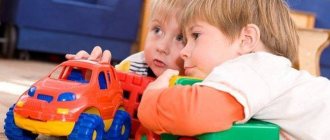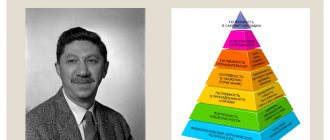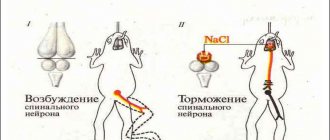“My child doesn’t want to socialize”, “Her boy doesn’t go to kindergarten, he will have problems with socialization” - isn’t it true, you often come across these and similar phrases on forums, and hear them on playgrounds.
They are based on fears and experiences related to the fact that the child will not be able to successfully undergo the process of adaptation in society, will not learn to communicate, will be isolated, expelled from all social groups.
To get rid of fears or, conversely, realize how difficult the situation is, read what socialization is, what it is like and why it is impossible to talk about it as a one-sided process.
In this article:
What is socializationTypes of socializationSocialization as a two-way process
Socialization concept
The concept of socialization is synonymous with the concept of “personality development” in developmental psychology. However, their key difference is that the first involves a view from the side of society, and the second - from the side of the individual himself.
Also, the concept of socialization is synonymous with the concept of “upbringing” in educational psychology, but not in its narrow sense, but in its broad sense, when it is assumed that the whole life, the whole system educates.
Socialization is a complex multi-level process of an individual’s assimilation of social reality. On the one hand, this is a process that helps a person to assimilate everything that surrounds him in social reality, including social norms and rules of society, elements of culture, spiritual values developed by humanity, and therefore helps him subsequently act successfully in this world.
On the other hand, this is also a process that is associated with how exactly this learned experience is further applied by the individual, that is, how the individual, being an active social subject, implements this experience.
The most important factors in the socialization of an individual are the phenomenon of a person being in a group and self-realization through it, as well as his entry into increasingly complex structures of society.
Socialization as a two-way process
You may have noticed that above we were always talking about how people join society and learn to live according to its laws.
But this is not an entirely correct approach - society cannot exist without people. Agree that it would be just a candy wrapper. Society becomes a society when people revive it, change it, make adjustments, fill it with new ideals and aspirations. Each person realizes himself, expresses dreams, goals, and tries to realize them.
Photo by Dio Hasbi Saniskoro: Pexels
This is best seen in small groups. For example, you had a child. Without noticing it, you joined a group of moms who walks in the park every day. You discuss life, health, family. Don’t touch on issues of politics or economics—this was an unspoken decision. But you noticed that in the spring the path in the park was covered with holes, and strollers could not pass.
One by one you appeal to the administration, to some deputy - all to no avail. As a result, you form a public district committee and begin to act as an organization. Your community has transformed because you wanted it to. And now anyone who wants to become a member of the group will already adapt to the new rules.
Socialization is a unique process that allows each person to join society, become a successful member of it, develop and achieve their goals. Not only children, but also adults of any age take it.
Goals and objectives
The goal of socialization is the formation of a responsible and socially active generation, whose actions are regulated by social norms and public interests. It solves three main problems:
- integrates the individual into society;
- promotes the interaction of people through their assimilation of social roles;
- preserves society through the production and transmission of culture from generation to generation.
Socialization is the result of a person’s mastery and active use of traditional sociocultural heritage while maintaining and developing their individuality.
The role and functions of socialization institutions in the development of personality
A complex and comprehensive process that contains all areas of human life.
Functions:
- Education and development of social knowledge. Mastering language skills, adopting views, interests, horizons, beliefs.
- Mastery of the totality of human achievements in production, spiritual and social terms, traditions, rules and norms inherent in society.
- Mastering the process of communication, behavior patterns aimed at fulfilling rights and responsibilities.
- Collection and implementation of innovations.
Table: Socialization tasks
| Natural-cultural | The closest approach to a certain level physically and sexually from birth to death. A person needs to achieve the canons inherent in his society - rules of etiquette, kinesthetic gestures, gender-role norms of behavior. |
| Socio-cultural | This group includes cognitive, moral and ethical tasks characteristic of age periodization. |
| Socio-psychological | The process of developing personal self-awareness, choosing one’s position, goals in society, self-affirmation. |
Mechanisms
Every society has socialization mechanisms through which people convey information about social reality to each other. In sociological terms, there are some “translators” of social experience. These are means that transmit accumulated experience from generation to generation, contributing to the fact that each new generation begins to socialize. Such translators include various sign systems, cultural elements, educational systems, and social roles. Socialization mechanisms are divided into two categories: socio-psychological and socio-pedagogical.
Socio-psychological mechanisms:
- Imprinting is the imprinting of information on the receptor and subconscious levels. More common in infancy.
- Existential pressure - the assimilation of language and norms of behavior at an unconscious level.
- Imitation is following a model, voluntary or involuntary.
- Reflection is an internal dialogue during which a person critically thinks about and then accepts or rejects certain social values.
Social and pedagogical mechanisms:
- Traditional - a person’s assimilation of prevailing stereotypes, which occurs, as a rule, at an unconscious level.
- Institutional - triggered by a person’s interaction with various institutions and organizations.
- Stylized - functions when included in any subcultures.
- Interpersonal - turns on whenever there is contact with persons who are subjectively significant to a person.
Social and pedagogical problems of socialization
Universal characteristics of the socialization process
Stages of socialization
There are different approaches to periodizing the stages or phases of socialization. Since until the 60s of the 20th century it was believed that the process of socialization ends in youth, one of the typical ones was periodization, in which three stages were distinguished:
- primary - socialization of the child;
- marginal - socialization in adolescence;
- stable or conceptual (holistic) - socialization in the period from 17–18 years to 23–25 years.
One of the first to doubt that socialization ends in youth was the American scientist Orville G. Brim Jr., who in 1966 not only made the statement that socialization occurs throughout life, but also named the following differences between the socialization of children and adults.
Firstly, the socialization of adults is expressed mainly in changes in their external behavior, while children's socialization corrects (or, more correctly, forms. - A.M.)
basic value orientations.
Second, adults can evaluate the norms of society and their environment; children are only able to assimilate them (which is quite controversial - A.M.).
Third, adult socialization often involves understanding that there are many shades of gray between black and white; children do not distinguish these shades (which is also ambiguous. - A.M.).
Fourthly, socialization in childhood is based on complete obedience to adults and compliance with certain rules.
Adults are forced to adapt to the demands of different roles at work, at home, and so on (for children the situation is similar, but the roles are different. - A.M.
).
Fifth, adult socialization is aimed at helping a person master certain skills; The socialization of children mainly forms the motivation for their behavior (which is also not entirely true. - A.M.
.).
Description of the differences between the socialization of children and adults made by O.G. Brim Jr. is valuable, first of all, because for the first time he draws attention to the continuity of the socialization process throughout a person’s life. However, the specific content of these differences clearly indicates that O.G. Brim Jr. views socialization as a subject-object process. Therefore, all the differences he named have a bias towards the object characteristics of both children and adults in the process of socialization.
The view of socialization as a continuous process gave rise to new periodizations of its stages. Thus, a number of researchers began to distinguish between the stages of primary (before adolescence) and secondary (during adulthood) socialization. In Russian science, the point of view of G.M. has received some recognition. Andreeva, who distinguishes three stages of socialization - pre-labor, labor and post-labor.
The stages of socialization can be correlated with the age periodization of a person’s life. There are various periodizations, and the one given below (it is proposed by me) is generally accepted. It is very conventional (especially after the stage of adolescence), but quite convenient.
In accordance with this periodization, a person goes through a number of stages of socialization, each of which includes several stages.
The childhood stage includes the following stages: infancy (from birth to 1 year), early childhood (1–3 years), preschool childhood (3–6 years), primary school age (6–10 years).
The stage of adolescence is younger adolescence (10–12 years), older adolescence (12–14 years).
The stage of youth includes the following stages: early adolescence (15–17 years) and adolescence (18–23 years), youth (23–30 years).
The maturity stage includes early adulthood (30–40 years), late adulthood (40–55 years), and old age (55–65 years).
The stage of old age is divided into stages: old age (65–70 years), longevity (over 70 years).
Each stage and each stage has its own specific content and course of socialization, which is determined by the peculiarities of the culture of a particular society. At each stage, and sometimes at each age stage, a person’s interaction with certain factors and agents of socialization develops somewhat differently, and the means and mechanisms of socialization differ.
Socialization factors
In dictionaries, a factor is defined as one of the necessary operating conditions of a particular process. Speaking about the process of human socialization, it is necessary to consider the conditions under which it occurs. There are different approaches to identifying the conditions of socialization and their classification.
Conditions or factors of socialization can be summarized into four groups.
The first is megafactors
(mega - very large, universal) - space, planet, world, which to one degree or another directly, but mainly through other groups of factors, influence the socialization of all inhabitants of the Earth.
Second - macro factors
(macro - large) - a country, ethnic group, society, state that influence the socialization of everyone living in certain countries (this influence is both direct and mediated by two other groups of factors).
Third - mesofactors
(meso - average, intermediate) - conditions for the socialization of large groups of people, distinguished: by the area and type of settlement in which they live (region, village, city, town); according to belonging to certain subcultures.
Mesofactors influence socialization both directly and indirectly through the fourth group - microfactors.
These include factors that directly influence specific people who interact with them - family and family education, neighborhood, peer groups, educational organizations and social education, religious organizations and religious education, various public, state, private, countercultural organizations, microsociety.
It is necessary to especially emphasize the multifactorial nature of the socialization process due to the fact that there were and are theories that absolutize one of the factors, ignoring or denying the role of many factors. Thus, old-style theologians recognized religious communities as the only socializing factor. Marxism affirms class as such. Orthodox Freudians consider a person’s belonging to one sex or another as a determining factor in his socialization, and chauvinists of all stripes consider the nation.
In reality, human socialization occurs in interaction with a huge number of different conditions that more or less actively influence his development. In fact, not all of these conditions have been identified, and of the known ones, not all have been studied. The factors of socialization identified above have also been studied to varying degrees. But the available data about each of them allows us to characterize them in the next section of the textbook.
Agents of Socialization
Microfactors influence human development through the so-called agents of socialization, that is, persons in direct interaction with whom his life takes place. At different age stages, the composition of agents is specific. Thus, in relation to children and adolescents, the American researcher G. Barry and his colleagues identified several types of socialization agents. Functionally, by the nature of their influence, they are guardians, that is, persons caring for the child, authorities, discipliners and teacher-mentors. These functions can be combined in one person, or they can diverge. By family affiliation, these can be parents, other family members (grandparents, aunts and uncles, brothers and sisters, other relatives and household members), as well as non-relatives (neighbors, playmates, teachers). By age, agents of socialization can be adults, peers, older or younger partners (siblings, comrades, etc.).
In youth or youth, the number of agents also includes a spouse, work colleagues, etc. In adulthood, one’s own children are added, and in old age, members of their families are added.
In their role in socialization, agents differ depending on how significant they are for a person, how interaction with them is structured, in what direction and by what means they exert their influence. Numerous studies have not revealed any hierarchy of the degree of influence and significance of agents of socialization, independent of the social system, kinship system and family structure (I.S. Kon).
Means of socialization
The socialization of a person is carried out by a wide universal set of means, content specific to a particular society, a particular social stratum, a particular age of the socialized. These include:
- methods of feeding and caring for a baby;
— language and speech of agents of socialization;
- developed household and hygienic skills and ideas;
- products of material culture surrounding a person;
— elements of spiritual culture (lullabies, fairy tales, signs, prejudices, customs, works of literature and art, etc.);
- style and content of communication in the family, in peer groups, in educational and other organizations;
— methods of reward and punishment in the family, in peer groups, in educational, professional and other socializing organizations;
- consistent introduction of a person to numerous types and types of relationships in the main spheres of his life: communication, play, cognition, subject-practical and spiritual-practical activities, sports, as well as in the family, professional, recreational, social, religious spheres.
Every society, every state, every social group (large or small) develops in its history a set of positive and negative, formal and informal sanctions - methods of suggestion and persuasion, regulations and prohibitions, coercive measures and pressure up to the use of physical violence, systems of methods of expression recognition, distinction, awards.
Thus, formal negative sanctions are a whole arsenal of punishments provided for by law, namely all kinds of warnings, reprimands, fines, arrest, imprisonment, deprivation of civil rights, confiscation of property, death penalty, excommunication, imposition of repentance, etc. Informal negative sanctions are expressions of surprise, ridicule, refusal to shake hands, meaning moral censure, refusal to maintain friendly relations, unkind gossip, etc. (J. Szczepanski).
With the help of these methods and measures, the behavior of a person and entire groups of people is brought into line with the patterns, norms, and values accepted in a given culture.
Mechanisms of socialization
Socialization of a person in interaction with various factors and agents occurs through a number of, so to speak, “mechanisms.” There are different approaches to considering the “mechanisms” of socialization.
Thus, the French social psychologist Gabriel Tarde considered imitation to be the main mechanism of socialization. American scientist Uri Bronfenbrener - progressive mutual accommodation (adaptability) between an active, growing human being and the changing conditions in which it lives. Neil Smelser (USA) considers four psychological mechanisms to be the most important: imitation, identification, shame and guilt. He defines the first two as positive, and the other two as negative. V.S. Mukhina considers identification and separation of the individual as mechanisms of socialization, and A.V. Petrovsky - a natural change in the phases of adaptation, individualization and integration in the process of personality development.
Summarizing the available data, we can identify several universal psychological and socio-pedagogical mechanisms of socialization.
The psychological mechanisms of socialization include the following.
1. Imprinting
(imprinting, imprinting) - a person’s fixation at the receptor and subconscious levels of the features of vital objects affecting him. Imprinting occurs primarily during infancy. However, even at later age stages it is possible to imprint some images, sensations, etc. Thus, traumatic experiences received in early or preschool childhood (up to 6 years) - humiliation, cruel treatment, etc., leaving their mark on the emotional sphere personality, can have a “delayed effect”, giving rise to cruel or aggressive behavior, emotional coldness, etc. Another example is the image of a “beautiful lady” imprinted in adolescence or adolescence (and sometimes earlier) can interfere with normal relationships with women and negatively affect a marriage, because it determines an inflated level of demands on a partner.
2. Existential pressure
(from Latin
ex(s)istentia
- existence) - the influence of a person’s living conditions, which determines his mastery of his native language (in early childhood) and non-native languages at other age stages (in a situation of change in the linguistic environment), as well as the unconscious acquisition of norms of social behavior , immutable in his society and necessary for survival in it.
3. Imitation
- voluntary and involuntary following of any examples and patterns of behavior that a person encounters in interaction with people around him (primarily with significant persons), as well as those offered by the media.
4. Identification
(identification) is an emotional-cognitive process of a person’s assimilation of norms, attitudes, values, and behavior patterns as one’s own in interaction with significant persons and reference groups.
5. Reflection
- internal dialogue in which a person considers, evaluates, accepts or rejects certain norms, values, behavioral scenarios characteristic of the family, significant others, peer society, various socio-professional and ethno-confessional layers, etc. Reflection can be an internal dialogue of several types: between different “I”s of a person, with real or fictitious persons, etc. With the help of reflection, a person can be formed and changed as a result of his awareness and experience of the reality in which he lives, his place in this reality and himself.
The named psychological mechanisms of socialization operate in line with the socio-pedagogical mechanisms of socialization, which include the following, which I described in the late 70s. XX century
Traditional mechanism
socialization (spontaneous) is the assimilation by a person of norms, standards of behavior, views, stereotypes that are characteristic of his family and immediate environment (neighbors, friends). Social mores (traditions, customs, habits, stereotypes of mass behavior, etc.), widespread in specific regions, settlements, ethno-confessional and social strata, regulating the behavior of specific people, include prosocial, asocial, and antisocial (obscene language , drunkenness, theft, etc.) elements.
Their assimilation occurs, as a rule, on an unconscious level with the help of imprinting, uncritical perception of dominant stereotypes (that is, imprinting, existential pressure, imitation, identification).
The effectiveness of the traditional mechanism is very clearly manifested when a person knows “how to”, “what is necessary”, but this knowledge of his contradicts the traditions of his immediate environment. In this case, the French thinker of the 17th century Michel Montaigne turns out to be right, who wrote: “...We can repeat our own as much as we like, but custom and generally accepted everyday rules drag us along with them.” In addition, the effectiveness of the traditional mechanism is manifested in the fact that certain elements of social experience, learned, for example, in childhood, but subsequently unclaimed or blocked due to changed living conditions (for example, moving from a village to a big city), can “pop up” in human behavior during the next change in life conditions or at subsequent age stages.
Institutional mechanism
socialization, as the name itself implies, functions in the process of human interaction with the institutions of society and various organizations, both specially created for his socialization, and those implementing socializing functions along the way, in parallel with their main functions (industrial, social, club and other structures, as well as mass media). In the process of interaction of a person with various institutions and organizations, there is an increasing accumulation of relevant knowledge and experience of socially approved behavior, as well as experience of imitation of socially approved behavior and conflict or conflict-free avoidance of fulfilling social norms.
It must be borne in mind that the media (print, radio, cinema, television) as a social institution influence the socialization of a person not only through the broadcast of certain information, but also through the presentation of certain patterns of behavior of characters in books, films, and television programs. The effectiveness of this influence, as the French choreographer Jean Georges Nover, a reformer of Western European ballet, subtly noted back in the 18th century, is determined by the fact that “since the passions experienced by heroes are distinguished by greater strength and certainty than the passions of ordinary people, it is easier to imitate them.” People, in accordance with their age and individual characteristics, tend to identify themselves with certain heroes, while perceiving their characteristic patterns of behavior, lifestyle, etc.
Thus, all the previously mentioned psychological mechanisms of socialization operate within the framework of the institutional mechanism.
Stylized mechanism
socialization operates within a certain subculture. Subculture in general terms is understood as a complex of moral and psychological traits and behavioral manifestations typical of people of a certain age or a certain professional or cultural layer, which as a whole creates a certain style of life and thinking of a particular age, professional, social, ethno-confessional and any other group . But a subculture influences a person’s socialization to the extent and extent to which the group members who bear it (peers, colleagues, etc.) are referent (significant) for him.
That is, in line with the stylized mechanism, imitation and identification operate, first of all.
Interpersonal mechanism
socialization functions in the process of interaction between a person and significant persons. It is based on the psychological mechanism of identification. Significant persons can be parents (at any age), any respected adult, a peer friend of the same or opposite sex, etc. Naturally, significant persons can be members of certain organizations and groups with which a person interacts, and if they are peers, then they can also be carriers of an age subculture. But there are often cases when communication with significant persons in groups and organizations can have an influence on a person that is not identical to that which the group or organization itself has on him. Therefore, it is advisable to distinguish the interpersonal mechanism of socialization as specific.
Human socialization occurs through all the mechanisms mentioned above. However, in different gender, age and socio-cultural groups, in specific people, the relationship between the role of socialization mechanisms is different and sometimes significant.
Thus, in the conditions of a village, small town, town, as well as in poorly educated families in big cities, the traditional mechanism can play a large role. In the context of a large city, institutional and stylized mechanisms are especially evident. For people of a clearly introverted type (that is, inward-looking, highly anxious, self-critical), the reflexive mechanism can become the most important.
Certain mechanisms play different roles in certain aspects of socialization. So, if we are talking about the sphere of leisure, about following fashion, then the leading one is often a stylized mechanism, and the lifestyle is often formed with the help of a traditional mechanism.
* * *
From the above it follows that the socialization of a person is carried out in the process of his interaction with diverse and numerous factors, groups, organizations, agents, with the help of various mechanisms that not only complement each other, but are to one degree or another mismatched and contradict each other. All this objectively determines a certain degree of human autonomy, which is necessary for the formation of a personality capable of making decisions, resisting external pressure, etc.
In conclusion, we note that it is very useful for those who work with people to keep in mind the thought of Antoine de Saint-Exupéry: “Under no circumstances can someone else awaken in a person about whom he previously did not suspect anything. To live means to be born slowly. It would be too easy to take ready-made souls.”
Stages
Socialization is a step-by-step process. At each stage, the above-mentioned translators work differently, and special mechanisms are also included that contribute to better mastery of social reality.
In domestic literature, in particular, in textbooks on social psychology by G. M. Andreeva, three stages of socialization are distinguished: pre-labor, labor and post-labor. At each stage, the emphasis changes, and above all, the relationship between the two sides of socialization - in the sense of mastering experience and in the sense of transferring experience.
The pre-labor stage of socialization corresponds to the period of a person’s life from birth to the start of work. It is further divided into two independent periods:
- Early socialization is inherent in the period of time from birth to entry into school. In developmental psychology, this is the period of early childhood. This stage is characterized by uncritical assimilation of experience and imitation of adults.
- The learning stage covers the entire period of adolescence in a broad sense. It definitely includes time spent at school. But the question of which stage to include the student years has become the subject of debate. After all, many university and technical school students are already starting to work.
The labor stage of socialization corresponds to the period of human maturity, although it should be noted that the demographic boundaries of adulthood are very conditional. It covers the entire period of a person’s active labor activity.
The post-work stage of socialization implies the period of a person’s life after the end of the main work activity. It corresponds to retirement age.
Examples of manifestation
Each social group influences a person differently. For clarity, it is worth considering three different examples:
- Mom and dad teach the child the first words, developing his communication skills.
- At school, the student finds a group of friends, thereby establishing interpersonal relationships.
- On the Internet, a man found paintings by Russian artists that satisfied his spiritual needs.
To better remember the material on the topic, students need to learn the definition of agents of socialization, and then draw up a table and plan in their notebooks, which will indicate representatives of each group.
If you didn’t manage to master what you learned the first time, you need to analyze the table and name the agents that are most difficult to remember. At the end of the repetition, it is worth filling out a diagram indicating which subjects of socialization are included in a specific group.
Kinds
To understand the types of socialization, it is necessary to consider the social institutions corresponding to each stage of development. At the pre-labor stage, institutions facilitate the individual’s entry into the social world and his mastery of this world, its features and laws. During early childhood, the very first institution within which a person begins to master social experience is the family. This is followed by various children's institutions.
During the period of education, the individual begins to interact with the first more or less official representative of society - the school. It is here that he first becomes acquainted with the basics of socialization. Institutions corresponding to this period provide the necessary knowledge about the world around us. Also during this period, the peer group plays a huge role.
Labor stage institutions are enterprises and work collectives. As for the post-labor stage, the question remains open.
Based on the institutional context, two types of socialization are distinguished: primary, associated with the acquisition of experience from a person’s immediate environment, and secondary, associated with the formal environment, the influence of institutions and institutions.
Spheres
The main areas in which an individual masters social connections are activity, communication and self-awareness.
In the process of activity, a person’s horizons regarding various types of activities expand. Next, this new information is structured, and then the person focuses on a certain type of activity as the main one, the main one at this stage. That is, a hierarchy is built, comprehension occurs, and the central type of activity is determined.
Communication expands and enriches a person’s connections with the public. Firstly, there is a deepening of forms of communication, that is, a transition from monologue to dialogical communication. What does it mean? The fact that a person learns to decenter, to take into account the point of view of another as an equal communication partner. An example of monologue communication is the catchphrase and half-joking expression: “There are two points of view on this matter - mine and the wrong one.” Secondly, the circle of contacts increases. For example, with the transition from school to college, the process of mastering a new environment begins.
As a person masters new types of activities and new forms of communication, he develops his own self-awareness, which is understood as a person’s ability in general to distinguish himself from others, the ability to recognize himself as “I” and, along the way, develop some kind of system of ideas about life, about people, about the world around us. Self-awareness has three main components:
- Cognitive self is knowledge of some of one’s own characteristics and ideas.
- Emotional Self - is associated with a general assessment of oneself.
- Behavioral self is an understanding of what style of behavior, what modes of behavior are characteristic of a person and which ones he chooses.
As socialization occurs, self-awareness grows, that is, understanding oneself in this world, one’s capabilities, one’s preferred strategies of behavior. It is very important to note here that as self-awareness grows, a person learns to make decisions and choices.
Making decisions is a very important moment of socialization, because only adequate decisions allow a person to subsequently perform fairly adequate actions in the world around him.
Taken together, activity, communication and the development of self-awareness represent a process during which a person masters the expanding reality around him. It begins to unfold before him in all its diversity and in all its complexities.
Personality Formation Tools
To create a full-fledged personality, different tools and methods of socialization are used.
Fixed assets:
- speech skills;
- social rules and values, skills and abilities;
- position and role in society.
Mechanisms of socialization according to G. Tarde
| Repetition | Children tend to imitate adults, and subordinates tend to imitate leaders. All fashion trends, rituals and traditions are determined by the law of repetition. |
| Opposition | The mental confrontation of a person who needs to choose one model of behavior from several. |
| Device | The ability to make mutual concessions and reach agreement in the adaptation process. |
Creating an absolutely identical personality is not a task of socialization, since society implies the individual's manifestation of characteristics that help him to be self-realized.
Features of socialization of children with disabilities
The socialization of children with disabilities - disabilities - provides for their right to diagnosis, special programs of psychocorrectional work, organizational and methodological assistance to families, differentiated and individual education. For children with special educational needs the following are created:
- Specialized preschool educational institutions, schools or correctional classes in regular schools.
- Health educational institutions of sanatorium type.
- Special correctional educational institutions.
- Educational institutions for children in need of psychological, pedagogical and medical and social assistance.
- Educational institutions of primary vocational education.
Opportunities for obtaining secondary vocational and higher vocational education are being created for children with disabilities. For this purpose, special educational institutions are created, and various forms of integration are provided for in general institutions.
Despite this, the problem of socialization of children and adolescents with disabilities continues to remain relevant. The question of their integration into the society of “healthy” peers raises a lot of controversy and discussion.
Features of youth socialization
Young people are the most mobile part of society. This is the group that is most receptive to new trends, phenomena, knowledge and ideas about the world. But it is not sufficiently adapted to its new social conditions, and therefore is more easily influenced and manipulated. It has not yet formed stable views and beliefs, and both political and social orientation are difficult.
Young people also differ from other groups of society in that they are involved in almost all social processes, either directly or indirectly, for example, through their family.
This socio-demographic group includes people aged 16 to 30 years. These years include such important events as obtaining secondary and higher education, choosing and mastering a profession, creating your own family and having children. During this period, serious difficulties at the stage of life start are acutely felt. First of all, this concerns employment issues, housing and material problems.
At the present stage, the problems of psychological adaptation of young people are becoming more complex; the mechanisms for their involvement in the system of social relationships are complicated. Therefore, in addition to general education institutions, special youth socialization centers (YSCs) are being created. The main directions of their activities, as a rule, are related to the organization of socio-cultural and leisure events, the provision of information and consulting services, and the promotion of a healthy lifestyle. Youth is the main resource of society, its future. Her spiritual values and views, moral character and vitality are very important.
Features of socialization of older people
Recently, sociologists have begun to pay closer attention to the study of the socialization of older people. The transition to the post-work stage, adaptation to a new way of life does not necessarily imply a process of growth. Personal development may stop or even reverse, for example, due to a decrease in a person’s physical and psychological capabilities. Another difficulty is that for older people social roles are not clearly defined.
The topic of socialization of older people among researchers of this process is currently causing heated discussions, the main positions of which are completely opposite. According to one of them, the concept of socialization is not applicable to the period of life when all social functions of a person are curtailed. An extreme expression of this point of view is the idea of "desocialization" following the working stage.
According to another, a completely new approach to understanding the psychological essence of old age is needed. Quite a lot of experimental research has already been carried out confirming the continued social activity of older people. Only its type changes during this period. And their contribution to the reproduction of social experience is recognized as valuable and significant.
Interesting examples of socialization of people over 60
Vladimir Yakovlev, as part of his project “The Age of Happiness,” in the book “Wanted and Could,” highlights the stories of women who, through their personal example, proved that it is never too late to start making your incredible dreams come true. The motto of the book: “If it’s possible at 60, then it’s possible at 30.” Here are some inspiring examples of socialization in old age.
Ruth Flowers decided to become a club DJ at the age of 68. At the age of 73, under the pseudonym “Mami Rock,” she already gave several concerts a month, performed in the best clubs in the world and practically lived on airplanes, flying from one end of the world to the other.
Jacqueline Murdoch dreamed of working as a fashion model in her youth. At 82 years old - in the summer of 2012 - she became famous throughout the world, becoming the face of the Lanvin brand.
Evgenia Stepanova, upon reaching 60 years old, decided to start a career as a professional athlete. By the age of 74, she had achieved significant success in this field. Thanks to the large number of competitions for older athletes around the world, she has plenty of opportunities to ride, compete and win.









